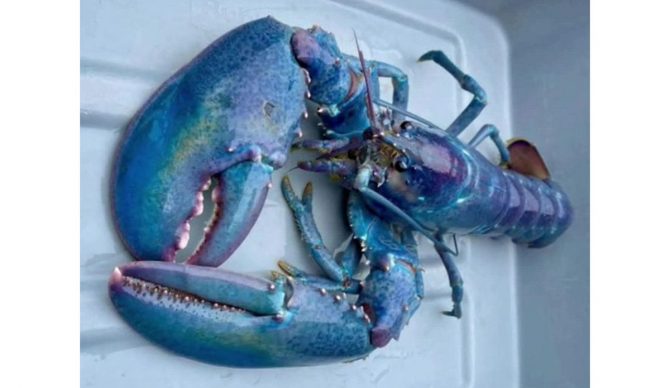
The lobster is likely the only one of its kind that the fisherman who pulled it up will ever see. Photo: Seacoast Science Center//Facebook
Lobsters are, in general, most the same color. But rarely, Mother Nature decides to throw a different hue on the palette and when she does, it’s pretty stunning. Recently, a commercial vessel owned by the Atlantic Lobster Company pulled up a very, very rare example of that in the form of a “cotton candy lobster.”
Cotton candy lobsters are literally 1-in-a-100 million. Lobster are usually a brownish/orange hue, but genetic mutations can cause their colors to change. It’s a little more common — although still extraordinarily rare — for a blue lobster to be found, but a lobster that’s blue, purple and even a bit of green? It’s almost unheard of.
According to the Smithsonian, the lobster was pulled in by Joseph Kramer, a 25-year-old who runs the Atlantic Lobster Company. In July, he headed out with his dad and girlfriend to check the lobster pots he’d set out off the coast of New Hampshire. In the last trap he pulled in, something caught his eye.
At first, he thought he’d found a blue lobster, an infrequent find in its own right. But when he looked closer, he realized it was something much more rare. Realizing he had something special, he took it to the Seacoast Science Center in Rye instead of selling it for food with the rest of his catch.
“I think it is definitely the only one I will ever catch, maybe even the only one I will ever see again in my lifetime,” he told Smithsonian Magazine. “I’m over the moon about catching it, and letting it be seen by everyone at the Science Center makes it even better.”
The color of a lobster can change due to the genetics. Different amounts of hues of red, yellow, and blue often make the normal color we think of when we picture a lobster. But when melanin is over or under produced, a whole rainbow can appear in a lobster’s shell.
“Lobsters come in a few color descriptions from orange, yellow, red, blues, and cotton candy which is a mixture of pinks and purples on a blue backdrop resembling ‘cotton candy,’ so this is where the name comes from,” Sam Rutka, an aquarist at the Seacoast Science Center, told IFL Science. “There are also split lobsters, for example red on one side and black on the other; as well as calico, another rare coloration where the lobster has a distinctive black and orange mottled color pattern.”
Although we do know that these mutations occur, it’s not entirely understood why they do so. It’s not exactly a good thing to stand out from the crowd when you’re often prey, and that likely adds to the infrequency of humans finding them.
Now, though, the cotton candy lobster will live in safety, along with two others that share the rare coloring at the Seacoast Science Center.
“I’m definitely happy to give it back and show it off,” Kramer said.

